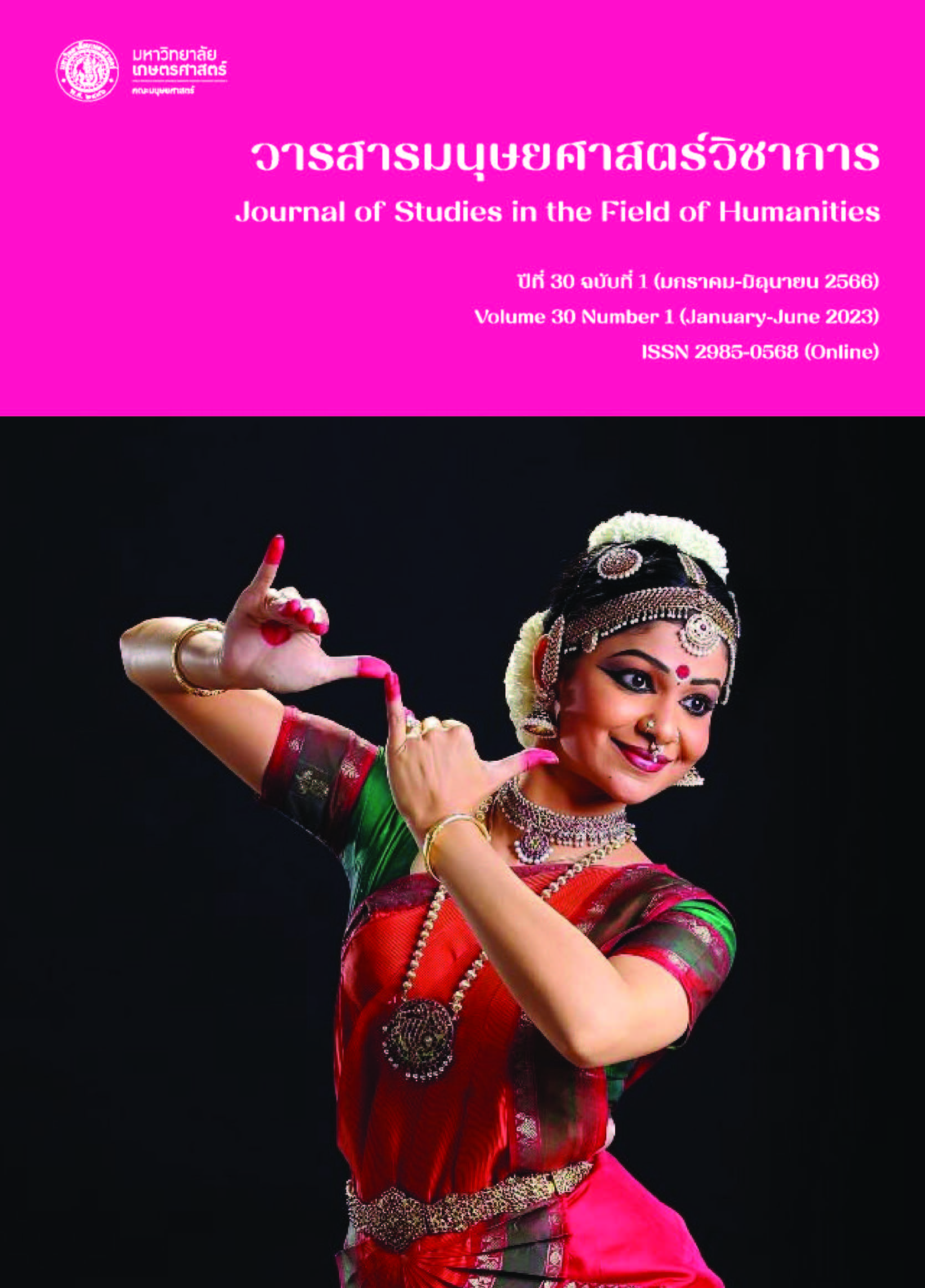Katayani Dance Drama: An Invention from Indian Bharatanatyam and Thai Classical Dances
Main Article Content
Abstract
The research “Katayani Dance Drama: A Dramatic Creation Inspired by Indian Bharatanatyam and Thai Classical Dance” aims to create a Katayani Dance Drama performance that conveys a story from the Hindu mythology. The inspiration and concept came from the TV Series "Durkha Maha Devi", which led to a study of the myth of the Hindu goddess Katyayani, one of Phra Uma’s aspects, who comes down to defeat demons. Then, the myth was adapted into a dance drama performance divided into 3 acts: Act 1-The Beast, Act 2-Uma’s Avatar, and Act 3-Killing Asura. It incorporates the uniqueness of traditional Thai dance dramas in 3 ways: (1) by having an opening dance, also known as the "hand offering dance", before the start of the performance in which all the protagonists, male and female, participate; (2) by using a performance genre based on Lakhon Nok in the style of royal drama with a fast and fun action; (3) by having a performance where the performer's skill and beauty are highlighted with a dance that has an elegant and graceful style according to the traditional Thai classical dance style as in the form of the royal inner court female drama (Lakhon nai). As for the choreography, the principle was to combine two forms of traditional dance, namely one inspired by the lines from drawings of Thai classical dance positions and the other one inspired by the hand gestures, known as "mutra" in Bharatanatyam. There was also the use of historical identity elements to design the dance accessories and costumes, such as the dance drama costume pattern called "Yuen Krueang" like the male and female mannequins at Wang Na, the image of the Queen, the image of the Ramakien in the dance textbooks and the painting of the Buddhaisawan Throne Hall, etc. Adding conch shell sound and paying respect to Aarti at the end of the show adds to the sense and identity of Hinduism. The research explores the concepts, traditional knowledge and elements used for this creative performance, “Katayani Dance Drama”. It combines the identity of Thai traditional dance styles with Bharatanatyam. It is a new dance drama in a new style for Thai performances. The knowledge and experience gained from this creation is the integration of cross-cultural dance movements and acting styles by modifying the way of thinking, bringing the strengths of each art form together until becoming this creative work.
Article Details

This work is licensed under a Creative Commons Attribution-NonCommercial-NoDerivatives 4.0 International License.
References
กิตติธัช ศรีฟ้า. (2561). พระอินทร์ในบริบทสังคมไทย. วารสารศิลป์ พีระศรี, 6(1), 68-87.
จักรพันธุ์ โปษยกฤต. (2540). หุ่นวังหน้า. กรุงเทพฯ: กรุงเทพ (1984).
ธรรมจักร พรหมพ้วย. (2554). นาฏกรรมอินเดีย เอกสารประกอบการสอนวิชาทฤษฎีนาฏยศาสตร์. สืบค้นเมื่อ 10 มกราคม 2564 จาก https://www.academia.edu/43061631/.
บำรุง คำเอก. (2553) การเฉลิมฉลองเทศกาลทุรคาบูชา. วารสารดำรงวิชาการ, 9(2), 120-134.
ประวิทย์ ฤทธิบูลย์ และคณะ. (2564). รูปแบบการสร้างสรรค์นาฏศิลป์ที่สื่อให้เห็นถึงคุณค่าของปีกแมลงทับและส่งเสริมการสร้างมูลค่าเชิงพาณิชย์โดยผ่านมิติการแสดง. วารสารสถาบันวัฒนธรรมและศิลปะ, 22(2), 125-139.
ประเวศ อินทองปาน. (2561). สถานภาพและบทบาทของสตรีเพศตามแนวจริยศาสตร์ทางศาสนา. วารสารธรรมธารา, 4(2), 61-99.
ผาสุข อินทราวุธ. (2522). รูปเคารพในศาสนาฮินดู. กรุงเทพฯ: มหาวิทยาลัยศิลปากร.
พเยาว์ นาคเวก. (2526). เทพีทุรคาในเอเชียอาคเนย์ (วิทยานิพนธ์มหาบัณฑิต สาขาวิชาโบราณคดีสมัยประวัติศาสตร์). มหาวิทยาลัยศิลปากร, กรุงเทพฯ.
พุทธเลิศหล้านภาลัย, พระบาทสมเด็จพระ. (2514). เรื่องอิเหนา. กรุงเทพฯ: ศิลปาบรรณาคาร.
มูลนิธิส่งเสริมศิลปาชีพ ในสมเด็จพระนางเจ้าสิริกิติ์ พระบรมราชินีนาถ. (2552). วิวัฒนาการเครื่องแต่งกายโขน-ละครสมัยรัตนโกสินทร์. กรุงเทพฯ: แปลน โมทิฟ.
ราชบัณฑิตยสถาน. (2556). พจนานกรมฉบับราชบัณฑิตยสถาน พ.ศ. 2554. กรุงเทพฯ: ราชบัณฑิตยสถาน.
ศรัณ สุวรรณโชติ. (2562). ‘คีตนาฏการล้านนา’ การสร้างสรรค์ศิลปะการแสดงภายใต้กระบวนการสืบสานภูมิปัญญาล้านนา. ใน พรรัตน์ ดำรุง และคณะ (บ.ก.), ข้ามศาสตร์ ข้ามเวลา (น. 238-277). กรุงเทพฯ: ภาพพิมพ์.
ศิลปากร, กรม. (2540). ตำรารำ. กรุงเทพฯ: กองวรรณกรรมและประวัติศาสตร์ กรมศิลปากร.
ศิลปากร, กรม. (2557). จิตรกรรมฝาผนังพระที่นั่งพุทไธสวรรย์. กรุงเทพฯ: กรมศิลปากร.
สุรพล วิรุฬห์รักษ์. (2547ก). หลักการแสดงนาฏยศิลป์ปริทรรศน์. กรุงเทพฯ: จุฬาลงกรณ์มหาวิทยาลัย.
สุรพล วิรุฬห์รักษ์. (2547ข). วิวัฒนาการนาฏยศิลป์ไทยในกรุงรัตนโกสินทร์ พ.ศ. 2325-2477. กรุงเทพฯ: จุฬาลงกรณ์มหาวิทยาลัย.
สุรศักดิ์ ทอง. (2553). สยามเทวะ. กรุงเทพฯ: มติชน. Kshetra of Art. (2020). Mudras in Bharatnatyam. Retrieved July 19, 2021, from https://www.kshetraofart.com/2020/09/mudras-in-bharatnatyam.html?m=1.


